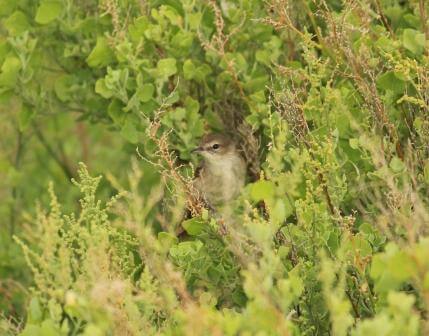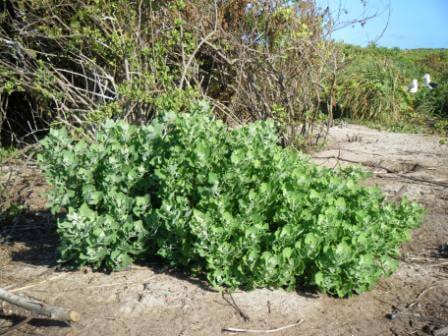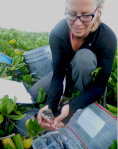Millerbird Drama: Season Finale on Laysan Island
August 26 – September 8, 2013
Andrea Kristof

Much-anticipated sight: Millerbird fledgling foraging in Chenopodium oahuense, a native shrub restored on the island. Photo by Megan Dalton.
The Millerbirds' fourth breeding wave of the 2013 season continued through our last days on Laysan Island, reflecting the incredible success of our project to ensure a future for this endangered species. Twenty-three pairs are currently displaying breeding behavior ranging from nest construction to feeding nestlings, making it the single largest breeding effort of the season to date.
Simultaneously, the hatch-year birds from the earlier breeding waves are attempting to carve out a place for themselves in the adults' world. We have observed a few young male fledglings from all three previous breeding waves of this year singing recognizable songs (although some of them are still a little raspy) and defending territories. Some of these hatch-year birds have experienced greater success entering the adult world than others. The (probable) hatch-year male that is defending the Southeast-of-the-Knoll territory has been consistently observed in that area, successfully fending off males from the resident, adult pairs to the north and northwest, as well as the intrusion of at least three young hatch-year males attempting to stake out a territory of their own.
This same young male has also been often observed in the company of a hatch-year female from the Northwest Bowl territory, sometimes engaged in courtship behavior with her. To the west, the young Catchment East male momentarily had it all—a prime territory and an interested female—only to have it all taken away one morning by the North-of-Cocos male, whose female (we suspect) ran off with the Catchment East male. He has since been observed singing, alone, in several other areas of the Millerbird core habitat. Along the northeastern fringes of the naupaka, the Pōpolo male has repeatedly lured the South-of-Northeast-Entrance female into his territory. So far, this new pairing has been tenuous and brief, and we've watched the South-of-Northeast-Entrance male venture north several times, chasing this female back into his territory.
These birds have been our version of celebrities this summer, each playing their respective role in the large soap opera that we have been enjoying in the Millerbird core habitat. They were a daily presence in our lives and a constant source of island gossip. We were shocked at the scandals, hopeful at new beginnings, and sad during their absences. As we depart Laysan, I think we will all spend the winter curious about what our Millerbird friends are up to in our absence. Will the Catchment East male ever settle down into a territory and secure a lady friend? Will the younger Pōpolo male successfully seduce the South of Northeast Entrance female away from her current partner? When the next Millerbird monitoring team arrives next year, will territories be established outside of the large northern naupaka patch? Will the 2013 hatch-years be feeding nestlings of their own?
Nature Sighting of the Week
We observed a sight that has been much anticipated for several years now: a Millerbird in ‘āweoweo (Chenopodium oahuense), a native shrub indigenous to both Nihoa and Laysan. A hatch-year bird from the Knoll territory was resighted on multiple occasions calling and foraging in one of the Chenopodium colonies just downhill from the northern naupaka patch, which has served as the primary residence of the Millerbirds on Laysan Island for the first two years.

Chenopodium oahuense is planted in areas where the invasive Pluchea indica was removed. This species was historically common on both Laysan and Nihoa (where Millerbirds have been documented to use it extensively).
Photo by Andrea Kristof.
Reuniting these two species—bird and plant—required substantial effort and time. In the planning stages of the Millerbird translocation, Chenopodium was identified as an important plant to have on Laysan. It was one of the three species that the Millerbird was known to utilize on Nihoa, the source of the translocated Millerbird population, and was historically abundant on Laysan. However, three years ago, when the Millerbird project team conducted its reconnaissance trip to Laysan, Chenopodium was found to be rare on the island. The shrub faces severe competition from an invasive species, Indian Fleabane (Pluchea indica), which significantly altered the prospective Millerbird habitat adjacent to the lake, outcompeting native vegetation like Chenopodium, the endemic Laysan sedge (Cyperus pennatiformis var. bryanii), and the endangered loulu palm (Pritchardia remota).
Chenopodium had relatively recently been reintroduced to Laysan by U.S. Fish and Wildlife Service (USFWS) Refuge personnel. Although early biological accounts from Laysan report that Chenopodium was the second-most abundant plant on the island, the introduction of rabbits caused its extirpation in the early 1900s. Seeing a Millerbird utilize this species is a wonderful culmination of countless hours of invasive species control and native plant propagation. We had already observed how these restoration efforts benefit many members of Laysan's ecosystem, but the presence of a Millerbird was definitely a landmark event.
Farewell to Laysan
This week USFWS Refuges commenced the closure of the Laysan Island field camp due to the impacts of sequestration. It has been difficult to contemplate leaving, because invasive plants that field crews have worked to eradicate for more than two decades could easily regain the upper hand. Rare and endangered native plants might be out-competed.
But seeing the Millerbird foraging in the Chenopodium reminds me of all that has been accomplished in the last few years, and I hope that the positive actions that many dedicated people have contributed to restoring Laysan's ecosystem will continue to resonate through future years. Just over the course of my short four years working on Laysan, there are three native species that once again call Laysan home after a century-long absence. There are also two non-native species that we eradicated from Laysan.
I like to envision that, in another five years, the young, endangered loulu palms that were planted along the eastern lakeshore will have matured into three-meter-tall fan palms visible from the western coast. I can imagine their broad fronds providing a much-needed respite from the summer sun for Laysan Albatross chicks, and their yellow flowers and juicy purple fruits providing an appetizing delicacy for the voracious Laysan Finches.
In seven years, perhaps some of the albatross chicks that we excavated when they'd been buried by wind-blown sand in the Northern Desert—a human-created desert, an unfortunate reminder of a rabbit introduction that denuded the island of its vegetation over a century ago—will return to their natal island in search of a mate. A couple of decades from now, I hope that some of the straggler green sea turtle hatchlings that we unearthed during nest excavations and protected from the zealous claws of ghost crabs as they made their way into the ocean will crawl out of the water one moonlit summer night to lay eggs of their own.
And I very much hope that sooner rather than later, a field crew will be restored to Laysan Island, so that past restoration work can be salvaged, so that the ecosystem can continue to be restored and monitored, and so that the biological wonders that occur here can be experienced by a new generation of conservation biologists.
 Andrea Kristof is a long-time Laysan camp manager and new member of the Millerbird team.
Andrea Kristof is a long-time Laysan camp manager and new member of the Millerbird team.


















































